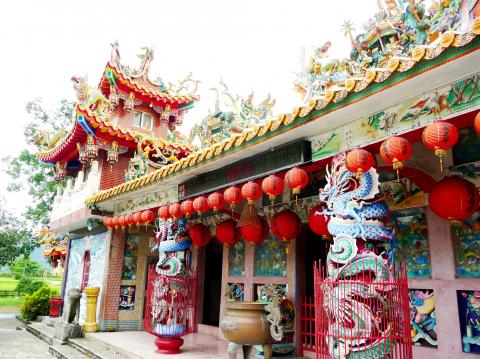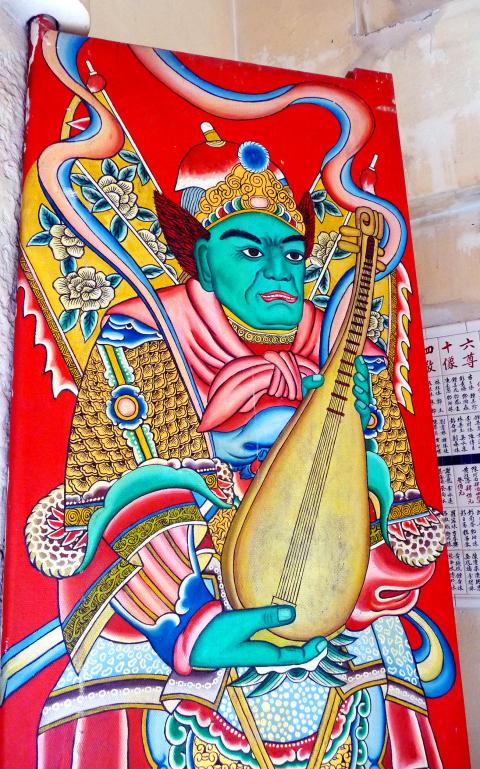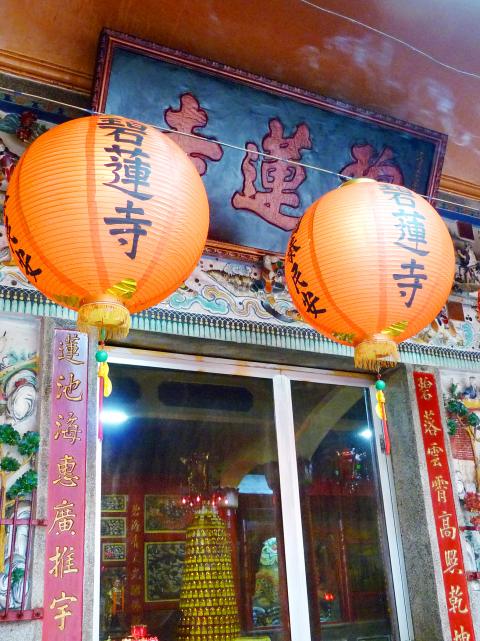I’m not interested in remnants of the colonial period as much as Chinese Nationalist Party (KMT) efforts after World War II to erase the Japanese imprint. Recently, I was thrilled to learn of a few old houses in the south that bear Republic of China (ROC) embossed flags on their facades — but where the post-1945 paint job is now so faded it’s possible to see Hinomaru (the Japanese flag) emblems that were the original adornments.
The KMT’s animosity toward Japan was understandable given Japanese aggression and wartime atrocities when it ruled Taiwan as a colony from 1895 to 1945. After 1949, however, Japan was a key trading partner and an important investor. What’s more, Taipei and Tokyo were both closely aligned with Washington. However, Japan’s 1972 decision to break off diplomatic ties with the ROC and establish formal relations with the People’s Republic of China provoked a fresh wave of anti-Japanese sentiment, at least among the ROC leaders.
In his chapter in the 2002 book New Asian Marxisms titled “Making Time: Historic Preservation and the Space of Nationality,” sociologist Marshall Johnson writes that a 1974 ROC Ministry of Interior edict, Main Points on the Elimination of Taiwan Japanese Era Colonial Rule Memorials and Historical Remains Manifesting Japanese Imperialism’s Sense of Superiority, commanded that Shinto shrines be destroyed, as well as the complete elimination of memorials and tablets.

Photo: Steven Crook
Several years ago, after hearing about this edict, I wrote the government and asked if they could tell me how many locations had been affected by the policy, and when (if ever) it had been canceled.
“We have never heard of [such an edict],” they replied. Perhaps they didn’t want to admit that the government had behaved in such a petty manner. Maybe they couldn’t be bothered to find the correct answer. But I should be fair to Taiwan’s bureaucrats: Almost every time I’ve sought information from one or another department, they’ve been helpful.
According to Johnson, “All Japanese stone lanterns and similar fixtures in temples and other public buildings were to be altered (removing the aesthetic quality making them nationally Japanese) or else destroyed,” as were Japanese calendrical inscriptions.

Photo: Steven Crook
One landmark given a Japanese-to-Han makeover years before the rupture in Tokyo-Taipei relations is Bilian Temple (碧蓮寺) in Fengtian (豐田), part of Hualien County’s Shoufeng Township (壽豐鄉).
Even today, this part of eastern Taiwan is thinly populated. Shoufeng has fewer than 18,000 residents. It’s hardly surprising that, when the government of overcrowded Japan took control of Taiwan, they identified this area as suitable for the development of immigrant villages.
The first batch of Japanese settlers arrived in what the colonial regime dubbed Toyota (豐田 in Japanese script, hence “Fengtian” 豐田 in Chinese) in 1913. In addition to housing for immigrants, the authorities built a police station, an elementary school and clinics.

Photo: Steven Crook
A Shinto shrine was consecrated in 1915 and dedicated to the Three Kami Deities of Cultivation (開拓三神), a trio of gods commonly worshiped in frontier regions of the Japanese Empire. Also enshrined here was Prince Kitashirakawa Yoshihisa (1847-1895), a distant relative of an 18th-century emperor and commander of an Imperial Japanese Army division during the 1895 invasion of Taiwan. The prince caught malaria and died near Tainan, after which he was elevated to a kami venerated by Shintoists.
Initially, the shrine’s major annual festival day was June 5. However, this coincided with the busiest time of year for farmers. Also, the heat made additional exertion unwise, so it was changed to Oct. 25.
Soon after the end of World War II, almost all of the Japanese citizens living in Taiwan were repatriated to Japan. Fengtian’s non-Japanese residents converted the Shinto shrine into a Buddhist place of worship. Local elders, it’s said, resisted proposals to demolish or extensively modify the building or its grounds.
However, in 1958 Super Typhoon Winnie blasted a path across Taiwan. The temple’s main building collapsed, so funds were raised to rebuild it as a Chinese-style place of worship. The new structure (address: 1 Mincyuan Street, 民權街1號) was completed in 1962, but several Japanese-era relics were left in place, and it’s these that make the temple worth visiting.
The traditional approach to the Shinto shrine would have been from the intersection of the thoroughfares now called Jhongshan Road (中山路) and Mincyuan Street. The torii gate (舊豐田神社鳥居) erected there a century ago was allowed to stand, because in 1946 it was repurposed as an entrance arch for Bilian Temple.
From the ex-torii, you need to go almost 800m to the southwest to find the temple. As you get close, you’ll see several daidoro, stone or concrete columns more than a meter in height. Kerosene lamps placed inside them illuminated the approach to the Shinto shrine. Bird, moon, and fire motifs are still visible, but the columns bear scars where Japanese-language inscriptions were expunged or covered with cement.
Right in front of the temple, where you’d expect to find guardian lions, there’s a pair of komainu (often called “lion-dogs”). Rather than face outward like guardian lions, they face each other across the temple’s central doorway.
The temple is on the edge of the town, and the fields nearby attract a variety of birds, including Malayan night-herons, Black-winged stilts, and Oriental Pratincoles.
Some other colonial-period buildings within walking distance of Fengtian Train Station have been preserved. The kendo training hall on the campus of Fongli Elementary School (豐裡國民小學) was thoroughly renovated less than two years ago.
A more unusual remnant is the “Wailing Wall” (哭牆) at 29 Dongping Street (東坪街29號), about 1km southeast of Bilian Temple. A Japanese family surnamed Tano (田野) lived here, but the wife died as a result of her second pregnancy. Her grieving husband visited this wall, and with his finger wrote the character tian (田) in the still-wet cement. If you search for it carefully, you’ll find it.

With one week left until election day, the drama is high in the race for the Chinese Nationalist Party (KMT) chair. The race is still potentially wide open between the three frontrunners. The most accurate poll is done by Apollo Survey & Research Co (艾普羅民調公司), which was conducted a week and a half ago with two-thirds of the respondents party members, who are the only ones eligible to vote. For details on the candidates, check the Oct. 4 edition of this column, “A look at the KMT chair candidates” on page 12. The popular frontrunner was 56-year-old Cheng Li-wun (鄭麗文)

“How China Threatens to Force Taiwan Into a Total Blackout” screamed a Wall Street Journal (WSJ) headline last week, yet another of the endless clickbait examples of the energy threat via blockade that doesn’t exist. Since the headline is recycled, I will recycle the rebuttal: once industrial power demand collapses (there’s a blockade so trade is gone, remember?) “a handful of shops and factories could run for months on coal and renewables, as Ko Yun-ling (柯昀伶) and Chao Chia-wei (趙家緯) pointed out in a piece at Taiwan Insight earlier this year.” Sadly, the existence of these facts will not stop the

Oct. 13 to Oct. 19 When ordered to resign from her teaching position in June 1928 due to her husband’s anti-colonial activities, Lin Shih-hao (林氏好) refused to back down. The next day, she still showed up at Tainan Second Preschool, where she was warned that she would be fired if she didn’t comply. Lin continued to ignore the orders and was eventually let go without severance — even losing her pay for that month. Rather than despairing, she found a non-government job and even joined her husband Lu Ping-ting’s (盧丙丁) non-violent resistance and labor rights movements. When the government’s 1931 crackdown

The first Monopoly set I ever owned was the one everyone had — the classic edition with Mr Monopoly on the box. I bought it as a souvenir on holiday in my 30s. Twenty-five years later, I’ve got thousands of boxes stacked away in a warehouse, four Guinness World Records and have made several TV appearances. When Guinness visited my warehouse last year, they spent a whole day counting my collection. By the end, they confirmed I had 4,379 different sets. That was the fourth time I’d broken the record. There are many variants of Monopoly, and countries and businesses are constantly